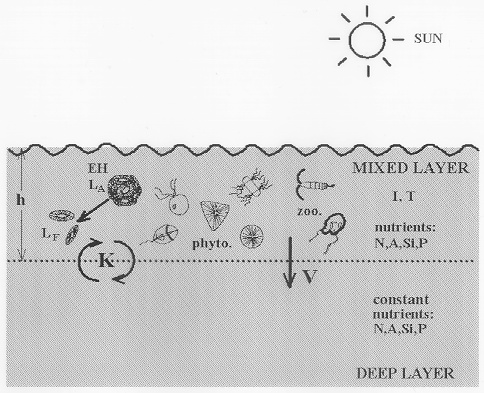A Modelling Study of Emiliania huxleyi in the NE Atlantic
Journal of Marine Systems, special issue on Emiliania huxleyi
(1995) 9(1/2):195-203.
Toby Tyrrell
Southampton Oceanography Centre
University of Southampton
Southampton SO14 3ZH, UK.
Email: T.Tyrrell@noc.soton.ac.uk
What was this work about? The problem that we addressed (myself in
collaboration with Arnold Taylor of Plymouth Marine Laboratory, as a part of
a wider European Community project called EHUX) was to try and
investigate the ecological niche of Emiliania huxleyi. We applied a
modelling approach to investigate this problem, and the model was
specifically applied to trying to understand the distribution of blooms of
E. huxleyi in the northeastern Atlantic, in particular a large bloom
in the area in 1991 that was extensively studied.

This is a picture of the bloom [click on it to see it full size].
Click here to see the
abstract
of this paper.

This figure shows the structure of the model we used. Both a shallow,
sunlit, photosynthetic zone and a deeper, inert layer were modelled.
Several different species of phytoplankton and zooplankton were modelled,
and the interactions between these biological components took place in a
dynamically-varying chemical and physical environment. Nitrate, ammonium,
silicate and phosphate nutrients were modelled, as was the transmission of
irradiance in the water and the effect of water temperature. Mixing of
nutrients, etc occurred between the two layers, and particles such as
phytoplankton were able to sink out of the surface mixed layer. The
phytoplankton compartment representing Ehux also had variables for
the numbers of attached coccoliths and the numbers of free coccoliths.
We tested several different hypotheses with our model and found that it was
not possible to reproduce the pattern of bloom occurrence when assuming
reliance of Ehux on any single water parameter. On the other hand,
we found that we were able to reproduce the distribution of blooms quite
accurately
(model results)
when it was assumed that E. huxleyi does well at a combination of
(i) phosphate in short supply in the water and (ii) light intensities on
average high throughout the surface mixed layer. E. huxleyi also
does better when the water is depleted of silicate which gives it an
advantage in the competition against diatoms.
These are the conclusions
to our paper.
References
Ehux
home page
Toby Tyrrell : T.Tyrrell@noc.soton.ac.uk

